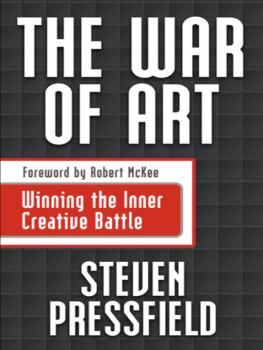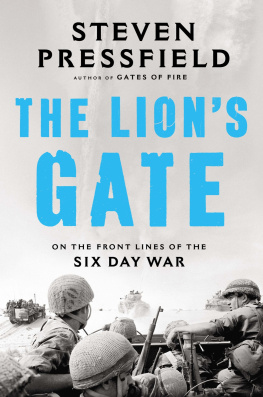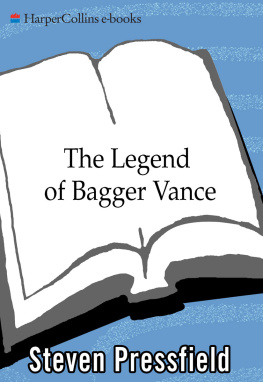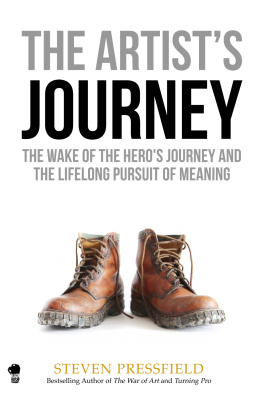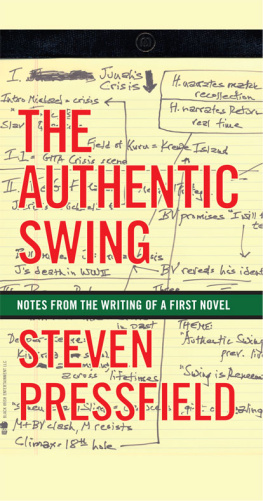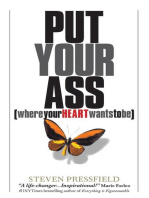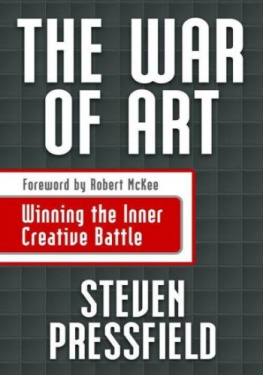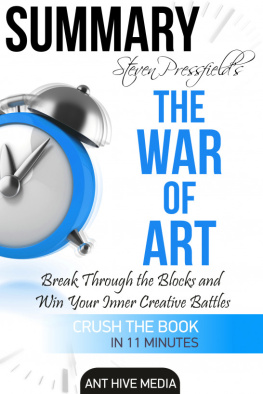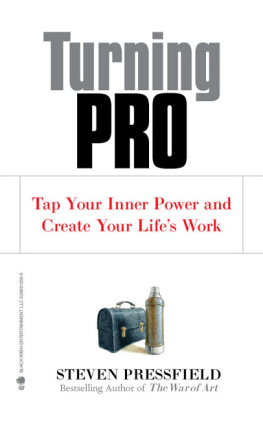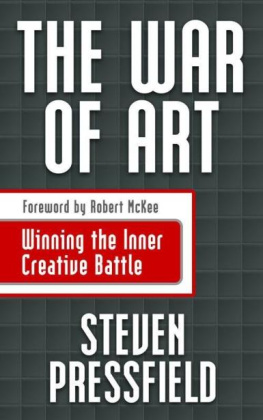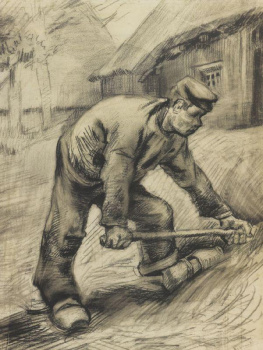Steven Pressfield - The War of Art: Winning the Inner Creative Battle
Here you can read online Steven Pressfield - The War of Art: Winning the Inner Creative Battle full text of the book (entire story) in english for free. Download pdf and epub, get meaning, cover and reviews about this ebook. year: 2002, publisher: Rugged Land, genre: Detective and thriller. Description of the work, (preface) as well as reviews are available. Best literature library LitArk.com created for fans of good reading and offers a wide selection of genres:
Romance novel
Science fiction
Adventure
Detective
Science
History
Home and family
Prose
Art
Politics
Computer
Non-fiction
Religion
Business
Children
Humor
Choose a favorite category and find really read worthwhile books. Enjoy immersion in the world of imagination, feel the emotions of the characters or learn something new for yourself, make an fascinating discovery.
- Book:The War of Art: Winning the Inner Creative Battle
- Author:
- Publisher:Rugged Land
- Genre:
- Year:2002
- Rating:5 / 5
- Favourites:Add to favourites
- Your mark:
The War of Art: Winning the Inner Creative Battle: summary, description and annotation
We offer to read an annotation, description, summary or preface (depends on what the author of the book "The War of Art: Winning the Inner Creative Battle" wrote himself). If you haven't found the necessary information about the book — write in the comments, we will try to find it.
Novelist Steven Pressfield (The Legend of Bagger Vance; Gates of Fire) goes self-help in The War of Art: Winning the Inner Creative Battle. Dubbing itself a cross between Sun-Tzus The Art of War and Julie Camerons The Artists Way, Pressfields book aims to help readers overcome Resistance so that they may achieve the unlived life within. Whether one wishes to embark on a diet, a program of spiritual advancement or an entrepreneurial venture, its most often resistance that blocks the way. To kick resistance, Pressfield stresses loving what one does, having patience and acting in the face of fear.
From Library JournalDrawing on his many years experience as a writer, Pressfield (The Legend of Bagger Vance) presents his first nonfiction work, which aims to inspire other writers, artists, musicians, or anyone else attempting to channel his or her creative energies. The focus is on combating resistance and living the destiny that Pressfield believes is gifted to each person by an all-powerful deity. While certainly of great value to frustrated writers struggling with writers block, Pressfields highly personal philosophy, soundly rooted in his own significant life challenges, has merit for anyone frustrated in fulfilling his or her life purpose. Successful photographer Ulrich (photography chair, Art Inst. of Boston; coeditor, The Visualization Manual) explores the creative impulse and presents an approach to developing creativity that, like Pressfields, will be relevant to artists and others. He identifies and explains seven distinct stages of the creative process: discovery and encounter, passion and commitment, crisis and creative frustration, retreat and withdrawal, epiphany and insight, discipline and completion, and responsibility and release. He also develops his view of the three principles of the creative impulse, which include creative courage, being in the right place at the right time, and deepening connections with others. Rooted in Eastern philosophy, Ulrichs fully developed treatise nicely updates the solid works of Brewster Ghiselin (The Creative Process), Rollo May (The Courage To Create), and Julia Cameron (The Artists Way). It also supplements Pressfields inspirational thoughts on overcoming resistance through introspective questions and practical exercises that further elaborate the creative process. Both books are recommended for public libraries needing additional works on creativity. Dale Farris, Groves, TX
Copyright 2002 Reed Business Information, Inc.
A succinct, engaging, and practical guide for succeeding in any creative sphere, The War of Art is nothing less than Sun-Tzu for the soul. What keeps so many of us from doing what we long to do? Why is there a naysayer within? How can we avoid the roadblocks of any creative endeavor-be it starting up a dream business venture, writing a novel, or painting a masterpiece? Bestselling novelist Steven Pressfield identifies the enemy that every one of us must face, outlines a battle plan to conquer this internal foe, then pinpoints just how to achieve the greatest success. The War of Art emphasizes the resolve needed to recognize and overcome the obstacles of ambition and then effectively shows how to reach the highest level of creative discipline.Think of it as tough love... for yourself. Whether an artist, writer or business person, this simple, personal, and no-nonsense book will inspire you to seize the potential of your life. AUTHORBIO: STEVEN PRESSFIELD is the author of international bestsellers The Legend of Bagger Vance, Gates of Fire, Tides of War, and Last of the Amazons. He lives in Los Angeles. PUBCOMMENTS:From the Introduction Robert McKee Bestselling Author of STORY: Substance, Structure, Style, and the Principles of Screenwriting On The War of Art Steven Pressfield wrote The War of Art for me. He undoubtedly wrote it for you too, but I know he did it expressly for me because I hold Olympic records for procrastination. I can procrastinate thinking about my procrastination problem. I can procrastinate dealing with my problem of procrastinating thinking about my procrastination problem. So Pressfield, that devil, asked me to write this foreword against a deadline, knowing that no matter how much I stalled, eventually I`d have to knuckle down and do the work. At the last possible hour I did, and as I leafed through Book One, Defining the Enemy, I saw myself staring back guilty-eyed from every page. But then Book Two gave me a battle plan; Book Three, a vision of victory; and as I closed The War of Art, I felt a surge of positive calm. I now know I can win this war. And if I can, so can you. To begin Book One, Pressfield labels the enemy of creativity Resistance, his all-encompassing term for what Freud called the Death Wish-that destructive force inside human nature that rises whenever we consider a tough, long-term course of action that might do for us or others something that`s actually good. He then presents a rogue`s gallery of the many manifestations of Resistance. You will recognize each and every one, for this force lives within us all-self-sabotage, self-deception, self-corruption. We writers know it as block, a paralysis whose symptoms can bring on appalling behavior. Some years ago I was as blocked as a Calcutta sewer, so what did I do? I decided to try on all my clothes. To show just how anal I can get, I put on every shirt, pair of pants, sweater, jacket, and sock, sorting them into piles: spring, summer, fall, winter, Salvation Army. Then I tried them on all over again, this time parsing them into spring casual, spring formal, summer casual.... Two days of this and I thought I was going mad. Want to know how to cure writer`s block? It`s not a trip to your psychiatrist. For as Pressfield wisely points out, seeking support is Resistance at its most seductive. No, the cure is found in Book Two: Turning Pro. Steven Pressfield is the very definition of a pro. I know this because I can`t count the times I called the author of The Legend of Bagger Vance to invite him for a round of golf, and although tempted, he declined. Why? Because he was working, and as any writer who has ever taken a backswing knows, golf is a beautifully virulent form of procrastination. In other words, Resistance. Steve packs a discipline forged of Bethlehem steel. I read Steve`s Gates of Fire and Tides of War back-to-back while traveling in Europe. Now, I`m not a lachrymose guy; I hadn`t cried over a book since The
LCC : BF408LC Extra Author Details: Mckee Robert : 1941- [Author Of Introduction]Library Codes : LCCN: LC: n94077375 VIAF: 89801579 ISNI:0000000108591464 Worldcat: lccn-n94077375Words : 24519DDC : 153.35OCLC_OWI : 701712Pages : 115Steven Pressfield: author's other books
Who wrote The War of Art: Winning the Inner Creative Battle? Find out the surname, the name of the author of the book and a list of all author's works by series.

